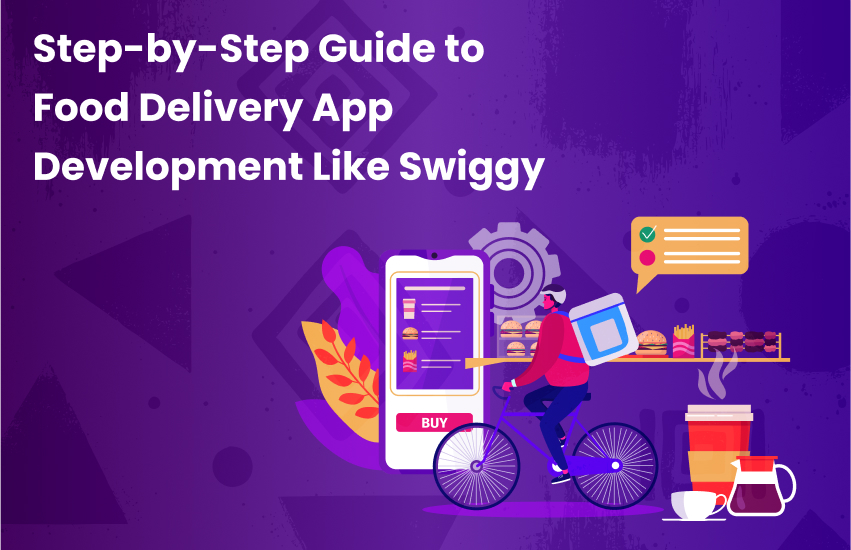Step-by-Step Guide to Food Delivery App Development Like Swiggy

How to Build an App for the Food Industry Like Swiggy?
The way we order food has changed dramatically, thanks to platforms like Swiggy. Food delivery apps have made life easier if you're craving a quick snack or need a full-course meal delivered to your doorstep. But have you ever wondered what it takes to build a food delivery app like Swiggy?
If you want to dive into food delivery app development, this blog is for you! We'll walk you through the entire process, from choosing the right features to understanding the technology behind it. Whether it's food delivery application development or even expanding into grocery delivery application development, this guide will help you turn your idea into reality.
So, if you're serious about launching your own food or grocery delivery app, read this blog until the end. This blog by Akkenna will equip you with the knowledge to build a successful app that competes with industry leaders like Swiggy. Let’s get started!
What is a Swiggy App?
Swiggy is a prominent Indian online platform that facilitates the delivery of food and groceries to customers' doorsteps. Through its user-friendly app, Swiggy connects users with a vast network of local restaurants and stores, offering a diverse range of cuisines and products. Key features include real-time order tracking, multiple payment options, and swift delivery services.
In addition to food delivery, Swiggy has expanded its services to include grocery delivery through Instamart, catering to the growing demand for quick and convenient access to daily essentials. Explore Swiggy Instamart.
Swiggy's success is mirrored by competitors like Zomato, another major player in India's food delivery sector. Zomato offers similar services, connecting users with a wide array of restaurants and providing timely deliveries. Both platforms have been instrumental in transforming the food delivery landscape in India.
Globally, platforms such as Uber Eats have made significant strides in the food delivery industry. Uber Eats operates in numerous countries, offering users access to a broad selection of local and international cuisines with efficient delivery services.
In the grocery delivery segment, apps like Zepto have emerged, focusing on ultra-fast deliveries. Zepto aims to deliver groceries within minutes, catering to consumers' increasing expectations for speed and convenience.
Future Predictions and Developments

The food and grocery delivery sectors are poised for continued growth and innovation. According to Statista, the online food delivery market in the United States is projected to reach approximately $350 billion in revenues by 2024, with the meal delivery segment contributing over $95 billion. Check out Statista's report.
Technological advancements are expected to play a pivotal role in shaping the future of these industries. The integration of artificial intelligence (AI) and machine learning can enhance personalized user experiences, optimize delivery routes, and improve overall operational efficiency. For instance, AI-powered recommendation systems can tailor menus and promotions to individual customer preferences, thereby enhancing the dining experience. Read more about AI in food delivery.
Moreover, the concept of dark kitchens or cloud kitchens is gaining traction. These are commercial cooking spaces that cater exclusively to online orders, reducing overhead costs and allowing for a more streamlined delivery process. This model enables businesses to focus solely on delivery without the need for a traditional dine-in setup.
However, the rapid growth of food delivery platforms has led to tensions with traditional restaurants. Some restaurant owners argue that these platforms leverage data to predict customer preferences, potentially disadvantaging traditional eateries. The launch of services promising food delivery within 15 minutes from dark kitchens has exacerbated this conflict.
How Does a Swiggy App Work?
Swiggy is one of the most popular food and grocery delivery platforms in India, providing users with a seamless and efficient way to order from their favorite restaurants and stores. Whether you're craving a meal from a nearby restaurant or need groceries delivered quickly, Swiggy ensures a smooth ordering and delivery process. Here’s how it works:
1. User Registration & Login
To use the Swiggy app, users first need to sign up or log in using their mobile number, email ID, or social media accounts. This step allows Swiggy to personalize recommendations and provide location-based services.
2. Location Detection & Restaurant Selection
Once logged in, Swiggy detects the user's current location using GPS and displays nearby restaurants, food joints, and grocery stores. Users can also manually enter their delivery address if they want the order delivered elsewhere.
3. Browsing & Ordering
Users can browse through a wide range of restaurants and grocery stores, filtering results based on cuisine, ratings, delivery time, offers, and price range. Once they find what they want, they can add items to their cart and proceed to checkout.
4. Payment Options
Swiggy offers multiple secure payment methods, including:
- Credit/Debit Cards
- UPI (Google Pay, PhonePe, Paytm, etc.)
- Net Banking
- Wallets
- Cash on Delivery (COD)
Users can also apply discount coupons and promo codes before making a payment.
5. Order Confirmation & Processing
After the payment is completed, the order is sent to the restaurant or grocery store. The restaurant confirms the order and begins preparation, while the Swiggy system assigns a delivery executive to pick up and deliver the order.
6. Real-Time Order Tracking
Swiggy provides live order tracking, allowing users to see the status of their order at different stages:
- Order Placed – The restaurant/store has received the order.
- Preparing – The food/groceries are being packed.
- Picked Up – The delivery partner has collected the order.
- On the Way – Users can track the delivery partner’s location in real time.
- Delivered – The order was delivered successfully.
7. Contactless & Scheduled Delivery
Swiggy offers contactless delivery for added safety and hygiene. Users can also schedule deliveries for later, ensuring convenience and flexibility.
8. Ratings & Reviews
After receiving the order, users can rate the restaurant, food quality, and delivery experience. This feedback helps improve service quality and assists other users in making informed choices.
Procedures for Creating a Swiggy-Style Food Delivery App
There are a few essential steps you must take to create a successful and lucrative app similar to Swiggy. At Akkenna, we follow this procedure while developing food delivery apps:
-
Define Your Business Model & Niche
-
Research & Competitor Analysis
-
Key Features for a Food Delivery App
-
Choose the Right Technology Stack
-
UI/UX Design for Better User Engagement
-
Develop & Test Your App
-
Deployment & Launch
-
Post-Launch Support & Updates
1. Define Your Business Model & Niche
Before starting your food delivery app development journey, defining the right business model is crucial. The food delivery industry offers various business models that cater to different needs and audiences. Here are some popular models to consider for food delivery and grocery delivery application development:
- Aggregator Model: This model connects users with multiple restaurants, acting as an intermediary platform where customers browse menus, place orders, and get their food delivered through independent couriers. Examples include Swiggy, Zomato, and Uber Eats.
- Cloud Kitchen Model: Also known as ghost kitchens, this model operates without dine-in facilities, focusing only on deliveries. These businesses reduce operational costs and rely on apps like Swiggy and Zomato for order fulfillment.
- Restaurant-Specific Model: Some food chains prefer to have their own dedicated food delivery apps. Brands like Domino’s and McDonald’s operate their delivery services to maintain full control over orders and customer experiences.
- Grocery & Food Delivery Hybrid: With the rise of grocery delivery applications, platforms like Swiggy Instamart and Zepto offer a combination of groceries and restaurant food delivery to cater to a broader audience.
Selecting the right business model influences the features, development cost, and overall success of your app.
2. Research & Competitor Analysis
A deep understanding of the market landscape and competition is key to building a successful food delivery application development strategy. Research should include:
- Market Size & Growth Potential: The global food delivery market is projected to reach $320 billion by 2029.
- Key Competitors: Analyzing major players like Swiggy, Uber Eats, and DoorDash helps identify gaps in service, pricing strategies, and user experiences.
- User Preferences & Pain Points: Studying customer feedback on existing platforms reveals insights into service shortcomings and areas for improvement.
- Pricing & Revenue Models: Different food delivery apps monetize their services through commission fees, delivery charges, premium subscriptions, and in-app advertisements.
By conducting thorough research, you can create a unique selling proposition (USP) that differentiates your platform from competitors.
3. Key Features for a Food Delivery App
A user-friendly app with essential features ensures better customer retention and engagement. Key features for different stakeholders include for food delivery application and grocery delivery application development:
User App Features
- Easy Sign-Up/Login: Provide options for Google, Facebook, email, and OTP-based login.
- Restaurant & Grocery Listings: Allow users to filter listings based on ratings, pricing, and offers.
- Order Tracking: Enable real-time GPS tracking with estimated delivery times.
- Multiple Payment Options: Support credit/debit cards, UPI, mobile wallets, and cash-on-delivery.
- Discounts & Loyalty Programs: Offer promo codes, cashback rewards, and referral discounts.
- Ratings & Reviews: Let users rate restaurants and delivery partners for transparency.
Restaurant Panel
- Order Management: Restaurants should be able to accept, modify, or cancel orders.
- Menu Management: Restaurants can update pricing, add new items, and offer discounts.
- Analytics Dashboard: Provide sales insights and customer behavior analysis.
Delivery Partner App
- Navigation & Route Optimization: Integrate with Google Maps for accurate routing.
- Earnings & Wallet: Delivery partners can track daily earnings and receive payouts.
- Order Scheduling: Allow drivers to accept or reject orders based on availability.
4. Choose the Right Technology Stack
The choice of technology significantly impacts the app’s performance, scalability, and security. A well-balanced food delivery application development stack includes:
Frontend Development
- React Native / Flutter: For cross-platform mobile app development.
- Swift (iOS) / Kotlin (Android): For native app development.
Backend Development
- Node.js / Python / Ruby on Rails: High-performance backend servers.
- MongoDB / PostgreSQL / MySQL: Databases for storing user and order data.
APIs & Third-Party Integrations
- Google Maps API: Location tracking & route optimization.
- Twilio / Firebase: For SMS & push notifications.
- Razorpay / Stripe / PayPal: Secure payment gateway integration.
5. UI/UX Design for Better User Engagement
A well-designed app ensures higher user retention rates. UI/UX best practices include:
- Simple Navigation: Keep the app interface clean and easy to use.
- Attractive Visuals: Use high-quality images, contrast colors, and readable fonts.
- Personalization: AI-driven recommendations based on user preferences improve engagement.
6. Develop & Test Your App
The phase of development and testing starts once the design stage is finished. Key testing methods include:
- Functional Testing: Confirms that every functionality functions as planned.
- Performance Testing: Ensure the application functions properly under a variety of settings.
- Security Testing: Defends user data from any online attacks.
- User Testing: Conduct beta testing to collect real-user feedback and optimize the app.
7. Deployment & Launch
The app is prepared for deployment following regressive testing. Launching involves:
- Publishing on App Stores: Deploying the app on Google Play Store and Apple App Store.
- Marketing Strategy: Using social media ads, influencer collaborations, and referral programs to increase downloads.
- Customer Support: Implementing a chatbot or support team to handle user queries and complaints.
8. Post-Launch Support & Updates
The work doesn’t stop after launch. Continuous improvements keep the app competitive. Key aspects include:
- Bug Fixes & Updates: Address technical issues and update app features regularly.
- New Feature Releases: Introduce AI-driven voice ordering, chatbot assistance, or subscription-based models.
- Marketing & Growth Strategies: Optimize for SEO, ASO (App Store Optimization), and targeted ad campaigns to increase visibility.
Popular Food and Grocery Delivery Apps and Their Development Costs
| Top Food Delivery/Grocery Apps | Tech Stack Used | Cost of Development | Available Platform | Downloads | Ratings |
|---|---|---|---|---|---|
| Swiggy | Java, Kotlin, React Native | $30k - $50k | Android, iOS | 100M+ | 4.4/5 (Google Play) |
| Zomato | Java, Kotlin, Node.js | $25k - $40k | Android, iOS | 50M+ | 4.3/5 (Google Play) |
| Uber Eats | Swift, Kotlin, Node.js | $40k - $60k | Android, iOS | 100M+ | 4.7/5 (Google Play) |
| Big Basket | Java, Angular, React Native | $30k - $50k | Android, iOS | 10M+ | 4.2/5 (Google Play) |
| Instacart | React, Node.js, Java | $50k - $70k | Android, iOS | 10M+ | 4.6/5 (Google Play) |
| Grofers | React Native, Java, Kotlin | $30k - $50k | Android, iOS | 10M+ | 4.1/5 (Google Play) |
| Zepto | React Native, Node.js | $20k - $40k | Android, iOS | 10M+ | 4.5/5 (Google Play) |
| Cookr | React, Node.js, Swift | $25k - $45k | Android, iOS | 1M+ | 4.0/5 (Google Play) |
How to Minimize food delivery app development costs?
Minimizing food delivery app development costs is crucial for businesses looking to enter the competitive market without overspending. By following certain strategies, you can reduce development costs while still building a high-quality, functional app. Here are some ways to minimize food delivery & grocery delivery application development costs:
- Focus on core features and avoid unnecessary additions.
- Choose hybrid development for cross-platform compatibility.
- Build an MVP to test with essential features first.
- Outsource to experienced, cost-effective development teams.
- Use open-source tools and pre-built templates.
- Prioritize UX/UI design to enhance user retention.
- Automate tasks to reduce manual effort and errors.
- Consider scalability while designing for future expansion.
- Perform continuous testing and iteration for quality assurance.
Ways to Monetize Your Food Delivery Apps like Swiggy
Monetizing a food delivery app like Swiggy involves leveraging different strategies to generate revenue while offering value to both customers and businesses. Here are some effective ways to monetize your food delivery application:
1. Commission from Restaurants
A common way to earn revenue is by charging restaurants a commission on each order placed through the app. This percentage can vary depending on the size and popularity of the restaurant, and it serves as a steady source of income for your app.
2. Delivery Fee
You can charge customers a delivery fee, either fixed or dynamic, based on factors like distance or order value. This helps cover logistics costs and adds another layer of revenue for your business.
3. Subscription Plans
Offer subscription-based services to customers, like free delivery or discounted rates on orders for a monthly or yearly fee. This creates a steady income stream while fostering customer loyalty.
4. Advertising
Allow businesses (restaurants, grocery stores, etc.) to advertise their products or promotions within your app. In-app ads can provide significant revenue without disrupting the user experience.
5. Dynamic Pricing
Implement dynamic pricing for high-demand periods, such as during festivals or peak hours. By adjusting delivery fees based on demand, you can maximize revenue during busy times.
6. Partnerships with Local Businesses
Collaborate with local businesses or food suppliers for sponsored promotions. In return for a partnership fee, you can highlight their services within the app.
7. Selling Customer Data (Anonymously)
You can monetize anonymized customer data (e.g., food preferences, purchasing habits) by selling it to market research firms or other businesses, provided it complies with privacy laws.
8. In-App Purchases
Offer additional services like premium delivery options, special packaging, or exclusive access to deals. This can be an upsell within the app to further increase revenue.
9. Loyalty Programs
Create a loyalty program where customers earn points or rewards with each order. You can sell these points to other businesses or use them as incentives for customer retention.
10. Cross-promotion with Other Apps
If your app gains a large customer base, you can monetize by promoting other apps or services, earning a commission for each download or purchase made through your platform.
By applying these monetization strategies, you can ensure that your food delivery app generates consistent revenue while maintaining customer satisfaction.
Conclusion
Building a food delivery app like Swiggy offers immense potential in a booming industry. By choosing the right business model, integrating key features, and providing a seamless user experience, you can create an app that stands out in a competitive market. Whether you're looking to develop an aggregator model, cloud kitchen, or hybrid solution, Akkenna's expertise in food delivery app development will help you turn your idea into a successful business.
If you're ready to bring your vision to life, we’re here to guide you through every step of the development process. Explore our other blogs for insights on mobile app development, UI/UX design, and digital marketing strategies to take your business to the next level.
Additionally, don’t hesitate to check out Akkenna’s full suite of services, including API testing, automation testing, and more, to ensure your app functions flawlessly. Contact us today for a free consultation and see how we can help make your food delivery app a success!

Muthukumar M
Digital Marketing Executive at Akkenna, specializing in developing effective strategies to drive online visibility and engagement. Expertise in SEO, social media campaigns, and leveraging data-driven insights to achieve business goals.